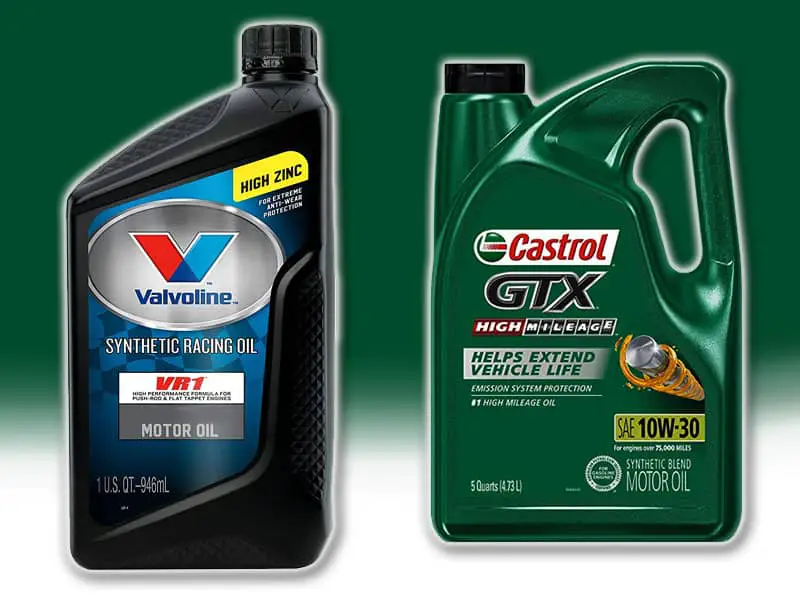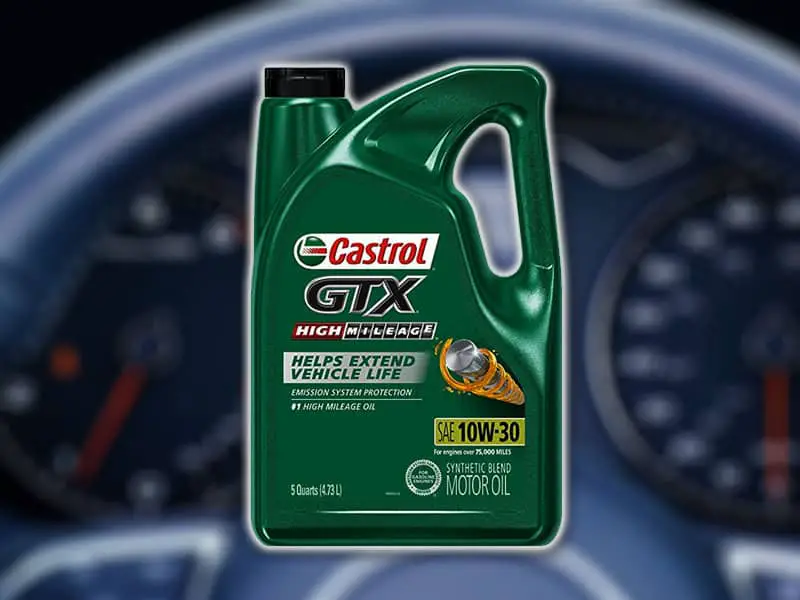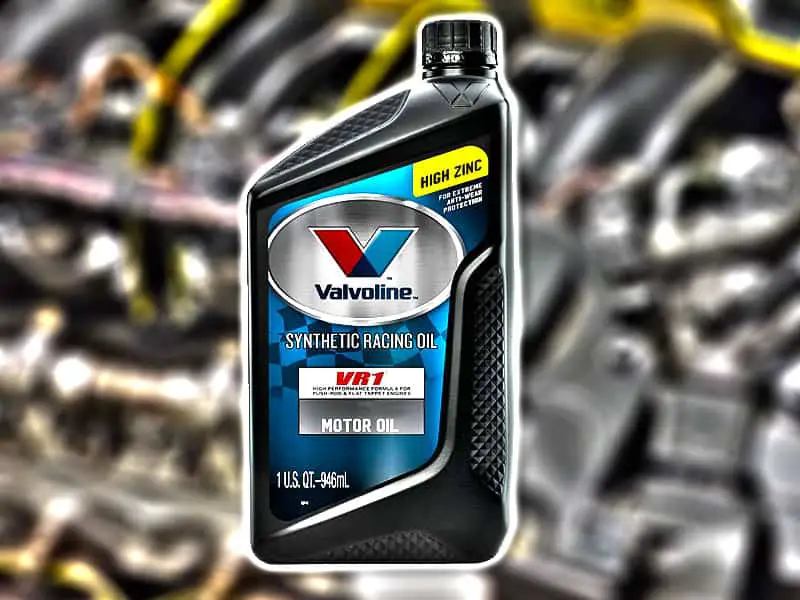Castrol GTX High mileage is a synthetic blend while Valvoline VR1 is fully synthetic oil, both are utilized for gasoline engines. GTX mainly emphasizes on providing higher mileage, on the other hand, VR1 focuses on engine cleaning.
GTX is a catalytic converter-friendly oil providing better protection from its early burn-off when the engine starts to heat up. During cold conditions, it performs really well. The high number of calcium-based detergents allow it to perform decently in washing away the sludge. The higher TBN provides a longer interval for changing the oil decreasing its consumption thereby, increasing fuel economy.


VR1’s main focus is to provide better engine cleaning. The high amount of calcium and magnesium-based detergent additives allow the removal of dirt and sludge more effectively. Its performance in colder conditions is also satisfactory. Anti-wear additives are abundantly added to this oil to minimize the wearing and tearing of the engine.

| Specifications | Castrol GTX High Mileage (10W-30) | Valvoline VR1 (10W-30) |
| Oil Type | Synthetic Blend | Fully Synthetic |
| Engine Type | Gasoline | Gasoline |
| Available viscosity grades | 5W-20, 5W-30, 10W-30, 10W-40, 20W-50 | 10W-30, 20W-50 |
| ILSAC | GF-6 | GF-5 |
| API | SN, SP, SN Plus | SM |
| Cost (1 Quart.) | 5.88 $ | 5.48 $ |
| Oil change frequency (miles) | 10,000-15,000 | 3000-4000 |
| Additives | Anti-wear, Detergents, Dispersants | Anti-foam agents, Anti-wear, Friction Modifiers |
| ACEA | Unavailable | A3/B4 |
Table of Contents
Comparison of Oil Burn-off Comparison
If the oil consists a higher quantity of lightweight molecules, it will increase the chances of its quick burn-off. This is because these lighter molecules won’t be able to resist the high temperature of the engine and will easily break down. It will lead the oil to reach its flashpoint at a lower temperature causing its rapid ignition.
GTX has a high flashpoint temperature compared to its rival. Conversely, VR1 has more quantity of lighter molecules so it has low flashpoint temperature. Therefore, GTX provides better protection in terms of oil burn-off.
| Oils in Comparison (10W-30 Grade oils) | Flash Point Temperatures (Degrees Celsius) |
| Castrol GTX High Mileage | 218.3 |
| Valvoline VR1 | 210 |
Comparison of Engine Wear-off Protection
To overcome the problem of wearing, anti-wear additives are added to the oil to form a thin layer around the moving parts of the engine. This layer inhibits the metal parts to slide over one another, minimizing the friction. More anti-wear additives will form a tougher and more resistant layer around the metal parts providing better protection against wearing and tearing.
Both the oils contain zinc and phosphorus as the main constituent of anti-wear additives. However, the concentration of both the elements is more in VR1 for providing better wearing resistance while the amount of boron and molybdenum is also on the higher side. A noticeable amount of Titanium additives is also present in VR1 however, these additives are absent in GTX.
| Oils in Comparison (10W-30 Grade oils) | Zinc Concentration (ppm) | Phosphorus Concentration (ppm) | Boron Concentration (ppm) | Molybdenum Concentration (ppm) | Titanium Concentration (ppm) |
| Castrol GTX High Mileage | 643 | 522 | 1 | 3 | 0 |
| Valvoline VR1 | 1080 | 941 | 205 | 66 | 32 |
Viscosity Comparison
The resistance to the flow of fluid is called kinematic viscosity. This viscosity needs to be high for the oil to perform well at extreme temperatures. Similarly, the greater the viscosity index less will be the variation in the viscosity of the oil if the temperature increases. The temperature at which the fluid loses its flowing capability is referred to pour point.
GTX has a lower kinematic viscosity at 40 o C however, at 100 o C its viscosity is greater than its rival. Meanwhile, VR1 has a higher kinematic viscosity at 40 o C, and at 100 o C, it drops below its competitor. The viscosity index of GTX is greater meaning that its viscosity will be less affected if the temperature rises from 40 o C to 100 o C. GTX performance in cold conditions is slightly better because of its lower pour point temperature compared to its counterpart.
| Oils in Comparison (10W-30 Grade oils) | Kinematic Viscosity @ 40 o C (cSt) | Kinematic Viscosity @ 100 o C (cSt) | Viscosity index (VI) | Pour point (Degrees Celsius) |
| Castrol GTX High Mileage | 65.4 | 11.7 | 154 | -36 |
| Valvoline VR1 | 68 | 10.7 | 146 | -33 |
Catalytic Converter Performance Comparison
The zinc and phosphorus (known as ZDDP) added as anti-wear additives, will convert into ash after the oil burns-off. The catalytic converter gets toxic due to this ash. This ultimately clogs the catalytic converter and causes hindrance to its performance.
VR1 contains high concentrations of both zinc and phosphorus compounds for its high load performance. On the other hand, GTX has lower zinc as well as phosphorus concentrations. So, for this reason, GTX due to the formation of low amount of ash has a better catalytic converter performance than that of its counterpart.
| Oils in Comparison (10W-30 Grade oils) | Zinc Concentration (ppm) | Phosphorus Concentration (ppm) |
| Castrol GTX High Mileage | 643 | 522 |
| Valvoline VR1 | 1080 | 941 |
Sludge Build-up Reduction Comparison
The impurities like dirt or moisture will react with the oxidized oil causing the formation of thick viscous black fluid called sludge. Detergents are added along with the dispersants to overcome this issue.
GTX contains calcium in abundance as a detergent additive. Sodium compounds are also present in large numbers. Small traces of magnesium-based detergents are also found in this oil. To overcome the problem of foaming, little amount of silicon compounds is also added.
Calcium and magnesium are the main ingredients in the VR1 due to their large concentrations. Anti-foaming agent (silicon) is also present in higher numbers compared to its peer to lower the problem of foaming. So, overall VR1 turns out to be superior in terms of preventing the sludge build up.
| Oils in Comparison (10W-30 Grade oils) | Sodium Concentration (ppm) | Magnesium Concentration (ppm) | Calcium Concentration (ppm) | Silicon Concentration (ppm) |
| Castrol GTX High Mileage | 124 | 8 | 1736 | 5 |
| Valvoline VR1 | 2 | 870 | 1186 | 9 |
Oil Change Frequency Comparison
The alkaline (base) additives are added to the oil to counterbalance the harmful acid being produced during the combustion process. TBN (Total Base Number) value is used to measure the amount of these additives. TBN value of the oil gradually decreases over time. Therefore, the higher this value lower will be the frequency to change the oil and vice versa.
TBN of GTX is higher so it requires a change after an interval between 10,000 to 15,000 miles while VR1 needs to be changed after every 3000 to 4000 miles because of its low TBN. So, the frequency of changing the oil is greater for VR1 than that of GTX.
| Oils in Comparison (10W-30 Grade oils) | TBN (Total Base Number) mg KOH/g |
| Castrol GTX High Mileage | 8.96 |
| Valvoline VR1 | 8.1 |
Price Differences
The price of both the oils is almost similar. However, GTX is slightly higher priced due to its higher mileage. The per quart cost of the GTX is 5.88$, which is marginally more than its rival. VR1 is faintly cheaper than its competitor with a price tag of 5.48 $ per quart.
Quick Summary
- GTX is a synthetic blend oil while VR1 is a fully synthetic oil used in gasoline engines.
- The catalytic converter performance of GTX is better because of its low amount of ash formation.
- Excessive amount of calcium and magnesium-based detergents present in VR1 gives it an edge to remove the sludge more diligently.
- GTX provides better oil burn-off protection due to its high flashpoint.
- VR1 has more amount of anti-wear additives to effectively reduce the wearing of the engine.
- The kinematic viscosity of VR1 at 40 o C is higher while at 100 o C GTX has a greater viscosity.
- GTX provides better performance during cold and chilly conditions.
- GTX has a lower oil changing frequency as it has higher TBN.
- VR1 is slightly cheaper than its rival.